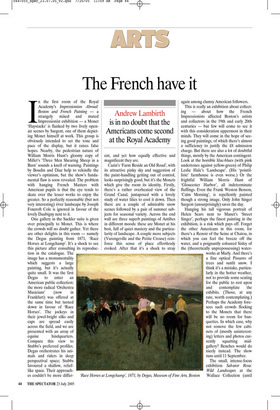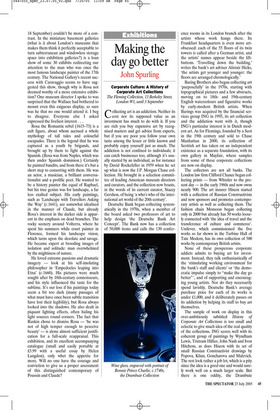The French have it
Andrew Lambirth is in no doubt that the Americans come second at the Royal Academy
In the first room of the Royal Academy’s Impressionism Abroad: Boston and French Painting — a strangely mixed and muted Impressionist exhibition — a Monet ‘Haystacks’ is flanked by two lively openair scenes by Sargent, one of them depicting Monet himself at work. This group is obviously intended to set the tone and pace of the display, but it raises false hopes. Nearby, the pedestrian nature of William Morris Hunt’s gloomy copy of Millet’s ‘Three Men Shearing Sheep in a Barn’ sounds a knell of warning. Paintings by Boudin and Diaz help to rekindle the viewer’s optimism, but the show’s fundamental flaw is soon revealed. The problem with hanging French Masters with American pupils is that the eye tends to skate over the lesser works to enjoy the greater. So a perfectly reasonable (but not very interesting) river landscape by Joseph Foxcroft Cole is ignored in favour of the lovely Daubigny next to it.
equine hindquarters. Compare this view to Stubbs’s preferred profiles. Degas orchestrates his animals and riders in deep perspectival space; Stubbs favoured a shallow, relieflike space. Their approaches couldn’t be more differ ent, and yet how equally effective and magnificent they are.
Cazin’s ‘Farm Beside an Old Road’, with its attractive pinky sky and suggestion of the paint-handling getting out of control, looks surprisingly good, but it’s the Monets which give the room its identity. Firstly, there’s a rather overheated view of the Grand Canal, juxtaposed with a lovely study of water lilies to cool it down. Then there are a couple of admirable snow scenes followed by a pair of summer subjects for seasonal variety. Across the end wall are three superb paintings of Antibes in different moods: these are Monet at his best, full of quiet mastery and the particularity of landscape. A couple more subjects (Varengeville and the Petite Creuse) reinforce this sense of place effortlessly evoked. After that it’s a shock to stray again among clumsy American followers.
This is really an exhibition about collecting — about how the French Impressionists affected Boston’s artists and collectors in the 19th and early 20th centuries — but few will come to see it with this consideration uppermost in their minds. They will come in the hope of seeing good paintings, of which there’s almost a sufficiency to justify the £8 admission charge. But there are also a lot of doubtful things, mostly by the American contingent. Look at the horrible lilac-blues (with pink undertones against yellow-green) of Philip Leslie Hale’s ‘Landscape’. (His ‘pointilliste’ farmhouse is even worse.) Or the frightful William Morris Hunt of ‘Gloucester Harbor’, all indeterminate fluffings. Even the Frank Weston Benson, ‘Calm Morning’, is repellently painted though a strong image. Only John Singer Sargent (unsurprisingly) saves the day.
Hanging his tall vigorous portrait of Helen Sears next to Manet’s ‘Street Singer’, perhaps the finest painting in the exhibition, is a risk which pays off. Forget the other Americans in this room, for there’s a Renoir of the Seine at Chatou, in which you can feel the breeze off the water, and a poignantly coloured Sisley of the (theoretically unprepossessing) waterworks at Marly. And there’s a fine optical Pissarro of trees and sunlit snow. I think it’s a mistake, particularly in the hotter weather, not to provide some seating for the public to rest upon and contemplate the exhibits. (Those, at any rate, worth contemplating.) Perhaps the Academy foresees such crowds flocking to the Monets that there will be no room for banquettes. In which case, why not remove the few cabinets of (mostly uninteresting) letters and photos currently squatting midgallery? Benches would do nicely instead. The show runs until 11 September.
The small, intense-focus exhibition Salvator Rosa: Wild Landscapes at the Wallace Collection (until 18 September) couldn’t be more of a contrast. In the miniature basement galleries (what is it about London’s museums that makes them think it perfectly acceptable to turn subterranean and windowless storage space into exhibition galleries?) is a loan show of some 30 exhibits redirecting our attention to the man who was once the most famous landscape painter of the 17th century. The National Gallery’s recent success with Caravaggio seems to have suggested this show, though why is Rosa not deemed worthy of a more extensive exhibition? One museum director I spoke to was surprised that the Wallace had bothered to mount even this exiguous display, so sure was he that no one would attend it. I beg to disagree. Everyone else I asked expressed the liveliest interest ...
Rosa the Romantic rebel (1615–73) is a cult figure, about whom accrued a whole mythology of tall tales and colourful escapades. There is the legend that he was captured as a youth by brigands, and brought up by them to fight against the Spanish. (Rosa was from Naples, which was then under Spanish dominion.) Certainly he painted bandits, and from there it’s but a short step to consorting with them. He was an actor, a musician, a brilliant conversationalist and a prolific poet. He wanted to be a history painter the equal of Raphael, but his true genius was for landscape, a far less exalted subject. His early paintings, such as ‘Landscape with Travellers Asking the Way’ (c.1641), are somewhat idealised in the manner of Claude, but already Rosa’s interest in the darker side is apparent in the emphasis on dead branches. The rocky scenery around Volterra, where he spent his summers while court painter in Florence, formed his landscape vision, which turns upon the desolate and savage. He became expert at brooding images of isolation and solitude: man overwhelmed by the mightiness of nature.
He loved extreme passions and dramatic imagery — look at his self-imolating philosopher in ‘Empedocles leaping into Etna’ (c.1660). His pictures were much sought after by 18th-century connoisseurs, and his style influenced the taste for the sublime. It’s our loss if his paintings today seem a bit too dark (many passages of what must have once been subtle transition have lost their legibility), but Rosa always looked into the shadows. He also dealt in piquant lighting effects, often hiding his light sources round corners. The fact that Ruskin chose to dismiss Rosa — ‘he was not of high temper enough to perceive beauty’ — is alone almost sufficient justification for a full-scale reappraisal. This exhibition, and its excellent accompanying catalogue (small and easily portable at £5.99 with a useful essay by Helen Langdon), only whet the appetite for more. Will no one have the courage and conviction to give us a proper assessment of this distinguished contemporary of Poussin and Claude?
















































 Previous page
Previous page